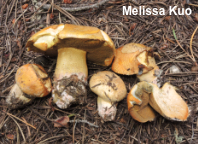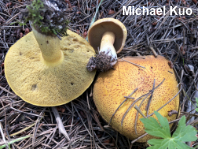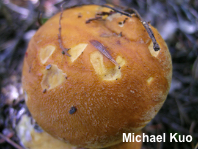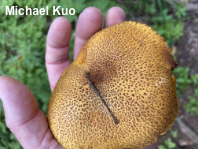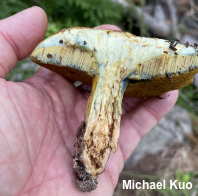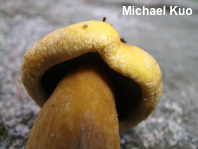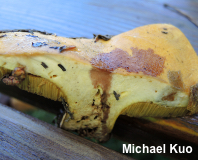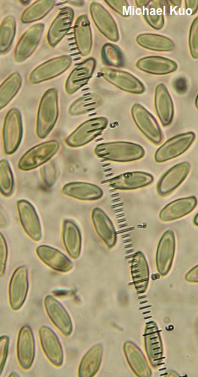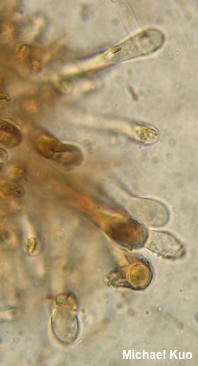| Major Groups > Boletes > Suillus > Suillus tomentosus |

|
Suillus tomentosus [ Basidiomycota > Boletales > Suillaceae > Suillus . . . ] by Michael Kuo Suillus tomentosus is one of only a few blue-staining species of Suillus. This fact, together with the orangish yellow, finely velvety cap and the association with 2-needle pines (primarily lodgepole pine and jack pine,) makes the mushroom fairly easy to identify. Look for Suillus tomentosus in western North America, and in the jack pine forests of the upper Midwest. Western North America's Suillus discolor is very similar (in fact it was originally named as a variety of Suillus tomentosus) but associates with 5-needle pines like western white pine and whitebark pine, and features a browner, less yellow cap. In Europe, Suillus variegatus also grows under Description: Ecology: Mycorrhizal with two-needle pines, especially lodgepole pine and jack pine; growing scattered or gregariously; summer and fall (also in winter in coastal California); originally described from Colorado; widely distributed in western North America, the northern Midwest, and montane Mexico; also reported from Central America. The illustrated and described collections are from Colorado. Cap: 6–10 cm across; convex becoming broadly convex or nearly flat; sticky or fairly dry; at first covered with a fine, grayish, felty covering, but often becoming more bald with age; yellow to orangish yellow; with maturity usually becoming finely areolate with a mosaic-like pattern of tufts and cracks; sometimes developing reddish spots and stains; the margin at first inrolled. Pore Surface: Brownish to orangish when young, becoming brownish yellow to brown, and eventually dark brown; bruising blue; with 2–3 angular pores per mm; tubes to 1 cm deep. Stem: 6–9 cm long; 1.5–2.5 cm thick; equal or tapering to base; yellowish orange; covered with fine brownish glandular dots; often staining blue, then slowly brown on handling; without a ring. Flesh: Whitish to yellowish in the cap; yellow in the stem; orange in the stem base; bluing on exposure, at least over the tubes and in the stem. Odor and Taste: Not distinctive. Chemical Reactions: Ammonia negative on cap surface; negative on flesh. KOH pinkish, then purple on cap surface; purplish on flesh. Iron salts bluish gray on cap surface and flesh. Microscopic Features: Spores 7–10 x 2.5–3.5 µm; boletoid-fusiform; smooth; yellowish in KOH. Basidia 20–25 x 4–5 µm; subcylindric; 4-sterigmate. Cystidia in bundles; often poorly defined individually; 30–70 x 6–12 µm; clavate, subclavate, or fusiform; smooth; thin-walled; golden brown in KOH. Pileipellis a cutis or ixocutis; elements 4–10 µm wide, smooth, hyaline to yellowish in KOH. REFERENCES: (C. H. Kauffman, 1921) R. Singer, W. H. Snell & E. A. Dick 1959. (Smith & Thiers, 1964; Snell & Dick, 1965; Snell & Dick, 1970; Smith & Thiers, 1971; Thiers, 1975; Grund & Harrison, 1976; Smith, Smith & Weber, 1981; Arora, 1986; States, 1990; Lincoff, 1992; Both, 1993; Barron, 1999; Bessette, Roody & Bessette, 2000; McNeil, 2006; Miller & Miller, 2006; Ortiz-Santana et al., 2007; Trudell & Ammirati, 2009; Kuo & Methven, 2010; Klofac, 2013; Desjardin, Wood & Stevens, 2015; Evenson, 2015; Cripps, Evenson & Kuo, 2016; Nguyen et al., 2016; Siegel & Schwarz, 2016; MacKinnon & Luther, 2021; McKnight et al., 2021; Zhang et al., 2022.) Herb. Kuo 08130703, 08121505, 07292101. Herb. DBG RMNP 2008-027, 2008-028, 2008-109, 2008-184, 2008-207, 2008-208; ROMO 2012 5022-17. This site contains no information about the edibility or toxicity of mushrooms. |
© MushroomExpert.Com |
|
Cite this page as: Kuo, M. (2022, July). Suillus tomentosus. Retrieved from the MushroomExpert.Com Web site: http://www.mushroomexpert.com/suillus_tomentosus.html |
